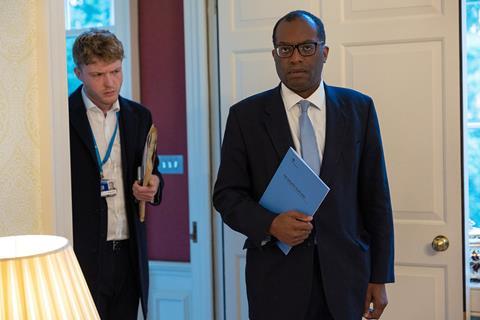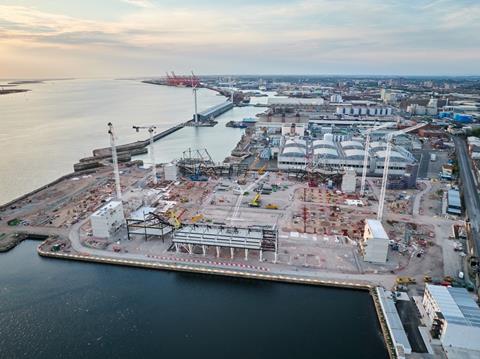Contractors are wary but the need for more recruits and a better-than-expected autumn statement mean it’s not all doom and gloom for the year ahead, writes Dave Rogers

Asked recently if he ever gets a good night’s kip on the eve of his firm’s annual results, Galliford Try chief executive Bill Hocking shot back: “I sleep like a log, mate.”
He has, of late, more reason than others to sleep soundly: last year, the firm saw the amount of cash it had in the bank go up, increased its turnover and hiked up its profit – before one-off items such as the cost of its deal for collapsed firm NMCN’s water business – by more than two-thirds.
He is aware enough to admit that whether a chief executive is going to sleep soundly or not on results eve is largely dependent on what is going to be published the following morning and, for some, the events of this year might mean more restless nights in the coming months.
>>See also: Top 150 Contractors and Housebuilders: full data table
While 2022 has thrown up challenges largely out of the sector’s control, 2023 threatens to see some of that fallout hit home.
Just hours before Morgan Sindall, the City’s long-time construction darling, wheeled out another impressive set of results, Russia began its invasion of Ukraine. The hope, back in February, was that the conflict might be over by now. Instead, it grinds on, and with it the collateral damage being caused to the global economy.

Since then we have seen rampant inflation, and firms such as industrial and logistics specialist Glencar have told Building they have been caught out by fixed-price contracts jumping in cost from what was agreed last summer to the reality once on site. Expect more of the same in the coming months.
Firms have also had to contend with the zombie government that emerged in the first week of July – when Boris Johnson resigned after one scandal too many – and the arrival of new prime minister Liz Truss eight weeks later.
Now gone herself, Truss already feels like a footnote – but the damage she and her chancellor Kwasi Kwarteng’s mini-Budget did is anything but history. Already firms are making staff redundant because of it, and concerns remain over the cost of borrowing, which has stabilised recently but has caused funders to think twice.
The year 2021 – the period covered by most firms’ latest available results which have been used to compile the top 150 league table – is starting to seem like a past golden age: contractors reported booming workloads and rising confidence, as the industry looked to spearhead the country’s way out of the economic drag of covid.
An impending recession, predicted by the Bank of England to be the worst in a generation, is coming our way, and despite the recent distraction offered by the World Cup – and all that sunshine – the coming of spring and any accompanying optimism seem some way off. We are in the grip of winter, in more ways than one.
It feels the ground keeps moving – and there are so many moving parts at the moment
Jonny Coubrough of broker Numis
Still, there are reasons to be hopeful: the industry needs more people than ever to come and work in it, and the autumn statement could have been a lot worse.
But back to 2021 for a moment. Turnover at all top 150 firms went up by an average 18% during the period with those in the top 10 seeing a near 14% rise in business – despite a fall in income among the top two biggest contractors.
Housebuilders rebounded well from the squeeze on income caused by the lockdowns of 2020 – with Taylor Wimpey, for example, seeing revenue rise by more than half, new Countryside owner Vistry up by a third and L&G-owned Cala Homes up by 85%.
Contractors enjoyed less spectacular growth but, still, some firms in the top 20, such as ISG, Bam and Mace, saw double-digit rises during the period.
Given we are at the end of 2022, there is an inevitable question mark over how firms whose financial year end is in December have fared this year, with the spring results season among quoted contractors a likely gauge of what to expect from private firms as well. Their numbers and what they reckon the future looks like will be more eagerly pored over than usual when Morgan Sindall kicks things off in February.
Max Jones, the director in Lloyds Bank’s infrastructure and construction team, says the sector’s natural lag in the economic cycle is helping it buck the trend seen elsewhere in the UK economy – so far. But he admits: “The impact of economic uncertainty is creating significant issues for construction.” And Brendan Sharkey, head of construction and real estate at accountant MHA, says: “Whilst the short-term outlook is reasonable, no one feels very confident about the back end of 2023.”
This year’s top 150 table shows a familiar feeling to the country’s five biggest contractors, with Balfour Beatty staying at number one followed by a rejigged – and revitalised – Kier, with Morgan Sindall in third spot.
The country’s largest private contractor remains Laing O’Rourke, while Keller, the listed groundworks contractor which carries out around half of its work in North America, slips to sixth and is replaced, just, by ISG – once a listed firm itself but since 2016 in the private hands of a thirty-something Texan billionaire called William Harrison and his investment company, Cathexis.
Workloads at the top two were down but by less than 4% at both – with Balfour Beatty shrugging off the cost of problem contracts in London residential and a £34m hit from an investigation by the US justice department which saw it plead guilty to fraud on a housing maintenance contract for the US military. Kier, meanwhile, said revenue was blighted by a £400m drop in workloads at its construction arm as the government, for which it carries out 70% of its work, put the brakes on greenlighting schemes as it took into account the cost of rampant inflation earlier this year.

Worries about the spending habits of clients were recently brought into focus by a trading update last month from another top 150 contractor, M&E firm T Clarke. It said that revenue for this year would be off by almost 10% of its budgeted workload to around £410m, after £40m of business was “reprogrammed” by clients into next year.
“It feels the ground keeps moving – and there are so many moving parts at the moment,” Jonny Coubrough, associate director at broker Numis, says of the issues facing contractors and those trying to plot a route through next year.
He no doubt speaks for many about the coming headwinds. And so, too, does Galliford Try’s Hocking when he wonders who is going to do all the work planned, recession or not. He says the current problems are “more about cost of living for individuals than it is about having a job or not having a job. In our sector, we are still looking for lots of people – all of our peers are.”
In its latest tender price forecast for the final quarter of this year, consultant Rider Levett Bucknall pointed out that “workload levels remain high, with recent construction output by value showing the highest five quarterly values ever recorded and new orders figures showing near record figures for three of the last four quarters”.
The current mood, then, feels like a phoney war. We know a recession is coming – enough people have said so – but thousands of people are not expected to be thrown out of work like in recessions of the past.
In fact, Beard finance director Fraser Johns says that mention of a recession is not much of a surprise for those who have been planning on how to cope with one for a while now.
“Let’s face it,” he says, “the economic complications confronting our firms are familiar foes. They have been items on our board meeting agendas for some time – the downturn in new work during the pandemic, followed by material shortages, stretched supply chains, rising material costs, increasing energy prices and ultimately rising inflation.”
Many of us made tough decisions during the covid downturn which will see our companies in good stead during the coming few years
Fraser Johns, finance director at Beard
He thinks the lessons learnt during covid will help contractors in the coming year. “Covid has made us organisationally stronger through a refocus on our people and our culture. Many of us made tough decisions during the covid downturn which will see our companies in good stead during the coming few years.”
While the war in Ukraine has been more about geopolitics, recent events at home have been largely self-inflicted.
The disastrous mini-Budget in September set in train a series of events so damaging that Kwarteng’s successor had to dump most of it in one fell swoop – including the plan to cut the top rate of tax from 45p to 40p, condemned by every one of those contacted by Building who would have benefited from it. One of those was Hocking, who is incredulous it was ever considered a good idea: “It’s beyond me why they did it.” And he had this to say about the mini-Budget in general: “They made pathetic, schoolboy errors. It made us a laughing stock on the international stage.”
Referencing George Osborne’s “omnishambles” budget of a decade ago – the one that came to be dominated by angst over whether Cornish pasties would be taxed – the Economist concluded: “The reaction to Kwasi Kwarteng’s fiscal statement on 23 September made the omnishambles budget look like a triumph for the ages.”
It led to an eagerly anticipated autumn statement and suggestions, trailed in the national press beforehand, that big-ticket schemes such as HS2 were to be pared back. Privately the chief executives of firms working on the railway were incredulous that such a move would even be given consideration. “We’re already digging the tunnels,” one told Building. “What are they going to do? Just leave them? That would be madness.”

In a briefing document published in the wake of new chancellor Jeremy Hunt’s plan, this time costed by the Office for Budget Responsibility – unlike the Kwarteng plan of finger-in-the-air tax cuts – broker Liberum said: “We still see the public sector as a good place to be.
“The autumn statement leaves the strong outlook for UK infrastructure intact, with a reiteration of the commitment to spend £600bn over five years. Infrastructure is key to growing the economy and levelling up.”
In its assessment, equity research firm Progressive added: “The autumn statement was, in our view, broadly positive for construction in general and countered a number of sector concerns.”
Among Hunt’s well-received messages were a commitment to nuclear, with Sizewell C getting the green light – the government at the end of last month formally pledged £700m to the scheme, whose backers include Laing O’Rourke, Kier and Mace – as well as the preservation of HS2 and a renewed pledge to levelling up.
Some clients have asked us to go back and look again at the price. Some projects have slipped, undoubtedly because of inflation
Mark Reynolds, chief executive of Mace
“As importantly, it maintained market stability,” Progressive added, which, it said, “should improve property investors’ risk appetite” as well as bring down the cost of imported materials such as steel as the pound strengthens against the dollar.
RLB says procuring projects against the backdrop of considerable market volatility continues to be a major challenge. “Clients are averse to what they view as unnecessary risk, so the continued open book or negotiated route where tendered subcontract prices can be established and visible remains in favour.”
But it warns some deals may stall because “main contractors and supply chains are still unable to fix prices for any length of time”. Instead, it advises: “Early pre-booking or reserving of key packages and their labour, to fix prices and increase certainty on delivery and programme, remains critical to help in derisking these variables.”
Still, clients are jittery. Mace chief executive Mark Reynolds admits: “Between March and June [this year] we had five major tenders worth £500m delayed or cancelled. Some clients have asked us to go back and look again at the price. Some projects have slipped, undoubtedly because of inflation.”
Materials and product price increases will stabilise, thanks to levelling or reducing commodities cost and weaker demand
Doug McCormick, executive director of Gleeds
The consensus, though, is that materials prices have probably peaked and are nothing like they were earlier this year. Gleeds group executive director Doug McCormick says: “Materials and product price increases will stabilise thanks to levelling or reducing commodities cost and weaker demand.”
Shortages may have delayed some decisions and, returning to an earlier point, there are worries over who will do all the work planned, given that construction vacancies remain at around a 20-year high. In the summer, the Construction Skills Network said an additional 266,000 workers would be needed to meet the level of anticipated output by 2026.

The figure equates to around 5.5% of the current workforce of 2.1 million. This is a tough ask, judging WSP’s recent survey: its headline finding was that the industry ranked only behind mining as the least attractive among 16- to 23-year-olds.
Truss had suggested a relaxation of the immigration rules which could have helped the size of the workforce, but last month Rishi Sunak ruled this out, telling the CBI conference: “We have proper control of our borders and are able to have a conversation with the country about the type of migration that we want and need. We weren’t able to do that inside the EU – at least now we are in control of it.”
But while the mood music might be sombre, many are not preparing to throw in the towel just yet. “While we should not underestimate the challenges ahead, we should also have confidence in our ability to overcome them,” says Beard’s Johns.
“It is tempting to be pessimistic about the immediate economic future. It is also tempting to talk ourselves, our customers and other key stakeholders into a more persistent downturn. But many construction firms have the credentials and the agility to carefully plan and work their way through.” It looks like we’re about to find out.
Top three public and private contractors
There is a familiar feel to the names of the biggest firms in the industry, whether they be listed or private.
Balfour Beatty stays in top spot of the entire table, as it has done for several years, and next month chief executive Leo Quinn celebrates eight years in the role after being brought in to stabilise a firm that had been racking up eye-watering losses.
Its key geographical areas remain the US, the UK and Hong Kong. After a foray into London building schemes, it remains first and foremost a civil engineer in its domestic market, with an appetite for big, complex projects whether it be tunnels and stations on HS2, the A14 widening scheme in Cambridgeshire or nuclear work at Hinkley.
Kier and Morgan Sindall follow. Kier managed to sell its housing business last April, a process frustratingly interrupted by the pandemic, and is targeting a turnover of £4bn to £4.5bn in the medium term, which is broadly expected to be around 2026.
Morgan Sindall, analysts reckon, is on course for a turnover of £3.4bn this year and an improved profit of £134m. Margins at both its construction and infrastructure businesses are set to hit targets, although even a business as seemingly bullet-proof as Morgan Sindall has been detrimentally affected by the mini-Budget – with the firm saying last month that its partnership housing division had seen sales slip in the aftermath.
The chances of Laing O’Rourke joining Morgan Sindall and becoming a public company seem to have fallen back after the country’s biggest private contractor said in the autumn its would-be successor to Ray O’Rourke was leaving. The firm has been here before with this sort of thing but it still caught most by surprise, with Seamus French spotted glad-handing HS2 bigwigs days before news of his departure broke.

While O’Rourke has stayed in top spot as the biggest private contractor this time around and with improved profit, its numbers for next year’s list will show that profit dwindled from £41m to just £2.7m, albeit on turnover up to £3bn. Whether it lists or not, who will pile into a firm offering that sort of margin? And potential investors won’t like the sound of another overseas problem contract, this time in Australia, which has blown a £76m hole in the firm’s accounts to March 2022.
Once a listed firm, ISG has moved into the top five of contractors and, like Morgan Sindall, has been reaping the rewards of a fit-out boom with the firm winning a string of deals including a £100m job to overhaul the Canary Wharf headquarters of Barclays Bank. The business accounted for more than half the group’s revenue in 2021, which improved 11% to £2.3bn. Earnings from the division were up a quarter to £36.5m.
Mace is trying to grow its fit-out business and muscle in on the big two – namely ISG and Morgan Sindall-owned Overbury – but it would still be a surprise if it, for example, bumped one of them out of the race to carry out work on a major scheme like the Google headquarters building.
Its construction boss, Gareth Lewis, proudly says it is the number one contractor in London and, despite several high-profile wins from a resurgent Lendlease recently, it tends to win more than it loses. Turnover during the period was up to £1.9bn, and the firm says it is still on course to hit a £3bn turnover target by 2026. Contracting remains its biggest division by far, at £1.5bn, but its consulting arm, which has better margins, is enjoying a big push, with chief executive Mark Reynolds suggesting the division will hit £500m by 2024.
Latest turnover among top public and private contractors
| Latest | Year end | |
|---|---|---|
| Balfour Beatty | £8.3bn | December ’21 |
| Kier | £3.2bn | June ’22 |
| Morgan Sindall | £3.2bn | December ’21 |
| Laing O’Rourke | £2.5bn | March ’21 |
| ISG | £2.3bn | December ’21 |
| Mace | £1.9bn | December ’21 |
Biggest subcontractors
It might rankle for firms with a turnover of £400m or above but some of this year’s top 150 are, in old money, subcontractors.
JRL Group, a sort of mini-Laing O’Rourke given the plethora of in-house capabilities that it boasts, saw turnover rise 7% to top £600m. The figure is likely to go up again after the firm picked up stricken offsite firm Caledonian Modular earlier this year and its Midgard business landed a high-profile deal at the end of last year to build a residential tower in Birmingham called the Octagon tower at the city’s Paradise development, where bigger players Sir Robert McAlpine and Bam have tended to mop up.
M&E stalwart NG Bailey saw turnover pegged back to just under £500m but, after the hit of the pandemic, recovered to post a £3m pre-tax profit in the year – although this is still some way short of the £20.5m profit it filed for 2019/20. It says it has embarked on a three-year business plan “that will see a return to pre-pandemic levels of profitability”. Turnover in 2019, the year before covid struck, was £570m.

Severfield is increasingly resembling a specialist contractor version of Morgan Sindall. The firm doesn’t do fancy, even though its jobs are high-profile like Everton FC’s new stadium, and instead has been keeping investors happy with a series of strong performances over the past few years, ever since it was knocked sideways by a spat over who was responsible for remedial work on the Cheesegrater tower which cost it £6m.
Income topped £400m for the first time, and last month it said revenue was up 20% to £235m in the first six months of the new financial year while the firm, the country’s biggest steelwork contractor, said pre-tax profit jumped 29% to £10.2m. On the back of a strong first half, broker Singer has raised the firm’s revenue expectations this year from £460m to £490m.
Once a London commercial specialist, Keltbray has pursued a strategy of diversification and is expecting turnover to be close to the £500m mark for its most recent financial year, after a couple of covid-impacted years. It has tightened up corporate governance under its chief executive, former Costain COO Darren James. Over the summer it was one of eight firms to admit bid-rigging in the demolition sector after a three-year probe by the Competition and Markets Authority. The investigation has still not formally wrapped up, but Keltbray expects to be hit with a fine in the region of £6m.
Its income this time of £390m is some way off the record £563m it posted in 2019, and accompanies £10.5m pre-tax profit. James has said he wants margins of 5%, adding Keltbray is looking at double-digit profit growth every year.
Latest turnover among top subcontractors
| Turnover latest | Year end | |
|---|---|---|
| JRL | £610m | December ’21 |
| NG Bailey | £499.5m | February ’22 |
| Severfield | £404m | March ’22 |
| Keltbray | £390m | October ’21 |
Ones to watch
Picking three firms to watch is always tricky, but here goes. Costain, after several years in the doldrums, has managed to get rid of those problem contracts, such as the Heads of the Valley Road in South Wales, which were weighing it down. Chief executive Alex Vaughan says the firm’s main markets are water, energy and transport, with business from all three showing improvement in the first half of its latest financial year. He adds: “We are seeing investment continuing to flow and in the amount of work we are bidding. These [jobs] are critical needs for the UK to grow and prosper. I don’t think there will be a recession in infrastructure.” He is also looking to grow the firm’s consultancy business. To this end, Costain and joint venture partner Mott MacDonald won £60m worth of work on the Stonehenge tunnel scheme as delivery assurance partner. Vaughan was privately cock-a-hoop with the win because among the firms it beat were WSP, Jacobs and Turner & Townsend.
McLaren has plans to challenge the big tier 1 contractors. The firm has racked up two years of consecutive losses and publication of its latest results was delayed, raising eyebrows and earning a rebuke from Companies House, but this was put down to the firm’s auditor, BDO, pulling out of construction and the subsequent knock-on delay in getting the numbers signed off. Paul Heather was brought in from Sir Robert McAlpine in the spring to a newly created role of group managing director for construction, and it has recently hired a former head of Kier’s major project business, Matt Cova, to head up its southern business. Heather said the firm was on track to return to the black for the year to July 2022 with a “modest” profit – expected to be between £1m and £10m on turnover up one-third to £726m. He added the firm is expecting turnover for the current year, which ends next July, to be around £850m with 80% of that already secured. It has notched up a couple of coups, landing the deal to turn the former Top Shop headquarters into a new Ikea store and last month dislodging McAlpine from a £200m scheme to extend the ExCeL centre in London’s Docklands.

Finally, a nod to a firm featured more extensively elsewhere on Building. Glencar, which was set up by two former McLaren staffers six years ago, is expecting turnover this year to be £417m, rising next year to somewhere around £550m. The firm says the increase in revenue from the previous period’s £160m is largely down to Brexit – with more firms wanting to store product in the UK rather than risk getting caught up in border snarl-ups – and the explosion in online shopping. Who knew the sometimes-maligned world of ”sheds” could be such a boom area?
Latest turnover among firms to watch
| Turnover latest | Year end | % change | |
|---|---|---|---|
| Costain | £1.1bn | December ’21 | 16 |
| McLaren | £541m | July ’21 | 2.9 |
| Glencar | £160m | September ’21 | 66.2 |




























No comments yet